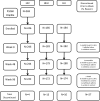Validity of Neuropsychological Testing in Young African Children Affected by HIV
- PMID: 30100780
- PMCID: PMC6085108
- DOI: 10.1055/s-0038-1637020
Validity of Neuropsychological Testing in Young African Children Affected by HIV
Abstract
Introduction: Western-constructed neuropsychological tests have been used in low and middle income countries to assess the impact of HIV/AIDS and other chronic illnesses. We explore using such instruments cross-culturally in a sub-Saharan Africa setting.
Methods: IMPAACT P1104S was a two-year observational study carried out at six clinical sites (South Africa- 3 sites, Malawi, Uganda and Zimbabwe) to assess and compare neuropsychological outcomes in three cohorts of children 5-11 years of age: HIV-infected (HIV), HIV-exposed but uninfected (HEU) and HIV unexposed and uninfected (HU). Descriptive statistics compared socio-demographic characteristics among children at sites. Instruments included the KABC-II cognitive ability, TOVA attention/impulsivity, BOT-2 motor proficiency tests, and BRIEF executive function problems. Test characteristics were assessed using intraclass and Spearman non-parametric correlations, linear regression and principal factor analyses.
Results: Of the 611 participants, 50% were male and mean age ranged from 6.6 to 8 years. In Malawi, Uganda and Zimbabwe, substantial proportions of families lived in rural settings in contrast to the South African sites. Intraclass correlation coefficients between weeks 0 and 48 were highest for the KABC scores, ranging between 0.42 to 0.71.Correlations among similar test domains were low to moderate but significant, with positive correlation between KABC Sequential and TOVA scores and negative correlation between BRIEF and KABC scores. TOVA response time scores correlated negatively with the BOT-2 Total points score. Strong and significant associations between individual measures of growth, disability and development with all test scores were observed. Performance-based measures were markedly lower for HIV compared to HEU and HU participants, even after controlling for age, sex and site. Factor analyses confirmed the underlying theoretical structure of the KABC scaled item scores.
Conclusion: The KABC, TOVA, BRIEF and BOT-2 were valid and reliable tools for assessing the neuropsychological impact of HIV in four sub-Saharan African countries.
Keywords: Africa; Neuropsychological testing; Pediatric HIV; reliability; validity.
Figures


Similar articles
-
African Multi-Site 2-Year Neuropsychological Study of School-Age Children Perinatally Infected, Exposed, and Unexposed to Human Immunodeficiency Virus.Clin Infect Dis. 2020 Oct 23;71(7):e105-e114. doi: 10.1093/cid/ciz1088. Clin Infect Dis. 2020. PMID: 31848582 Free PMC article.
-
Neuropsychological performance in African children with HIV enrolled in a multisite antiretroviral clinical trial.AIDS. 2018 Jan 14;32(2):189-204. doi: 10.1097/QAD.0000000000001683. AIDS. 2018. PMID: 29112069 Free PMC article.
-
Association between caregiver depression symptoms and child executive functioning. Results from an observational study carried out in four sub-Saharan countries.AIDS Care. 2020 Apr;32(4):486-494. doi: 10.1080/09540121.2019.1659917. Epub 2019 Aug 28. AIDS Care. 2020. PMID: 31462095 Free PMC article.
-
Cross-cultural assessment of HIV-associated cognitive impairment using the Kaufman assessment battery for children: a systematic review.J Int AIDS Soc. 2017 Jun 14;20(1):21412. doi: 10.7448/IAS.20.1.21412. J Int AIDS Soc. 2017. PMID: 28664684 Free PMC article.
-
Clinical outcomes of HIV-exposed, HIV-uninfected children in sub-Saharan Africa.Trop Med Int Health. 2016 Jul;21(7):829-45. doi: 10.1111/tmi.12716. Epub 2016 May 20. Trop Med Int Health. 2016. PMID: 27125333 Review.
Cited by
-
African Multi-Site 2-Year Neuropsychological Study of School-Age Children Perinatally Infected, Exposed, and Unexposed to Human Immunodeficiency Virus.Clin Infect Dis. 2020 Oct 23;71(7):e105-e114. doi: 10.1093/cid/ciz1088. Clin Infect Dis. 2020. PMID: 31848582 Free PMC article.
-
Neurocognitive function among HIV-infected children on protease inhibitor -based versus non-protease inhibitor based antiretroviral therapy in Uganda: a pilot study.BMC Pediatr. 2021 Apr 26;21(1):198. doi: 10.1186/s12887-021-02676-2. BMC Pediatr. 2021. PMID: 33902506 Free PMC article.
-
Central Nervous System Impact of Perinatally Acquired HIV in Adolescents and Adults: an Update.Curr HIV/AIDS Rep. 2022 Feb;19(1):121-132. doi: 10.1007/s11904-021-00598-3. Epub 2022 Feb 2. Curr HIV/AIDS Rep. 2022. PMID: 35107809 Free PMC article. Review.
-
Suubi+Adherence-Round 2: A study protocol to examine the longitudinal HIV treatment adherence among youth living with HIV transitioning into young adulthood in Southern Uganda.BMC Public Health. 2021 Jan 21;21(1):179. doi: 10.1186/s12889-021-10202-3. BMC Public Health. 2021. PMID: 33478469 Free PMC article.
-
Assessment Tools for Executive Function and Adaptive Function Following Brain Pathology Among Children in Developing Country Contexts: a Scoping Review of Current Tools.Neuropsychol Rev. 2022 Sep;32(3):459-482. doi: 10.1007/s11065-021-09529-w. Epub 2021 Dec 6. Neuropsychol Rev. 2022. PMID: 34870774 Free PMC article.
References
-
- Boivin MJ, Giordani B. Neuropsychological assessment of African children: evidence for a universal brain/behavior omnibus within a coconstructivist paradigm. Progress in brain research. 2009;178:113–135. - PubMed
-
- Sternberg RJ. Culture and intelligence. American Psychologist. 2004;59:325–338. - PubMed
-
- Giordani B, Boivin MJ, Opel B, Dia Nseyila DN, Lauer RE. Use of the K-ABC with children in Zaire, Africa: An evaluation of the sequential-simultaneous processing distinction within an intercultural context. International Journal of Disability, Development and Education. 1996;43(1):5–24.
-
- Abubakar A, van de Vijver FJR. How to adapt tests for Sub-Saharan Africa. van de Vijver FJR, editor. Handbook of Applied Developmental Science in Sub-Saharan Africa Abubakar, A. 2017;Chapter 11:197–212. XVIII; http://www.springer.com/978-1-4939-7326-2.
-
- Holding P, Anum A, van de Vijver FJ, et al. Can we measure cognitive constructs consistently within and across cultures? Evidence from a test battery in Bangladesh, Ghana, and Tanzania. Applied neuropsychology Child. 2016:1–13. - PubMed
Grants and funding
LinkOut - more resources
Full Text Sources
Other Literature Sources
